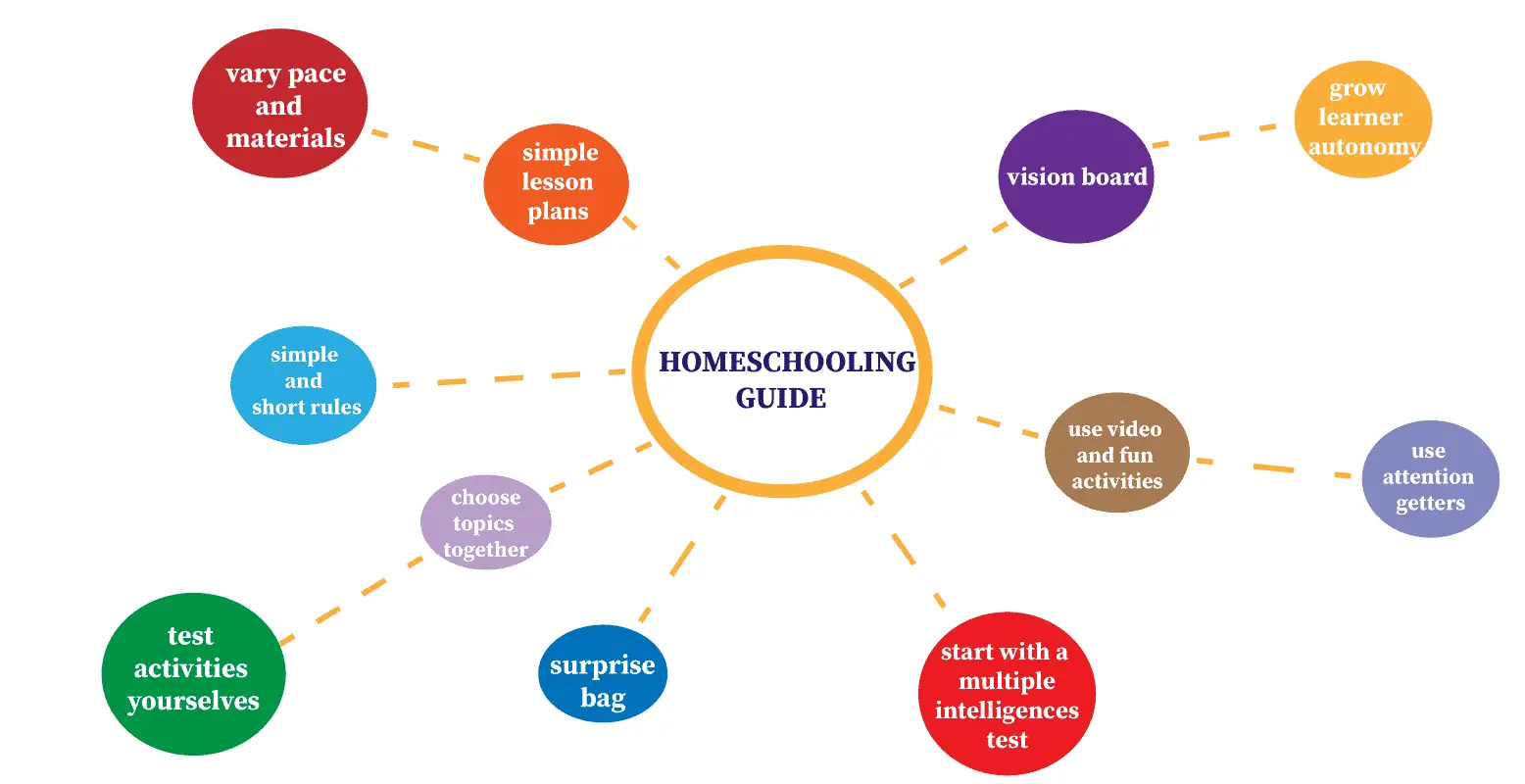10 Ways to Make Homeschooling Effective
Multiple Intelligences Test Surprise bags Simple Lesson Plan Template Attention Getters Pace of activities Learning Contract Vision Board Growing Learner Autonomy Less talking Find a Teaching BalanceHow to Manage Homeschooling Successfully
- First, find out what kind of learner your child is to choose the best activities for him. Try this multiple intelligences test. According to your findings, design and choose materials for your child’s dominant traits: more pictures, posters, and videos for a visual learner, more games and movement for a kinesthetic learner etc. You can read all about the importance of knowing your child’s learning style in this article on multiple intelligences.
- Children are curious, so introduce surprise elements: riddles, music, dramatic stories, games, discussions, jokes, stimulating pictures etc. You can also bring a surprise bag that includes items used to introduce the topic of the lesson; have the child guess what the topic used by looking at the items.
- Listen actively to your child and take into account his wishes. Since you are homeschooling, it is easier to take your time and do that. Respect his preferences, ask which activities he enjoyed most, and use them again.

- Grow learner autonomy-gradually offer more independence as a learner, both in terms of what they learn and how they learn. An example of how they learn: at first have your child listen to a model and repeat it; later have him look for words for himself/ do a reading puzzle by himself; when confident enough, offer appropriate resources and let him do the work by himself. You can also grow learner autonomy by offering your child playful learning experiences. For inspiration and ideas, read this article on learning through play activities.
Offer feedback in the form of constructive criticism, but also praise. Opt for variety, but also be consistent in everything you do.
- Be adaptable and flexible -act quickly when things don’t go as planned, prepare backups; be ready to assume different roles within a lesson: the prompter, the controller, the resource, the assessor. For inspiration and ideas of free activities and resources, make sure to read 13 Sites With Free Resources for kids.
- Know what you are teaching: read the lesson, do the exercises, think of what possible questions the child might have about the topic, try the activities yourself.
- Give clear and simple instructions; make sure the child understood them (ask him to explain what he has to do; ask a question to check).
- Give the lesson structure by following a simple lesson plan: introduce the topic (through a video, a poster, a song etc); discuss the lesson and have your children practice what has been discussed; your child actively works with the topic of the lesson (draw a project, make a presentation; have an interview, record a video etc).
- Prompt your child to correct himself first; if he cannot, offer the right answer/explanation; have him repeat. Offer reinforcements (praise, hugs, clapping, high fives etc) and create a positive learning environment.
- Always set time limits; make sure your child knows when to start and finish an activity; announce when there is little time left (eg 1 more min)
- Children’s attention span is limited so always be ready to get and maintain your child’s attention: make constant eye contact, decide on gestures for when you want to talk, you want them to speak etc. Use attention getters: you say “ready”, they say “ok”; you say “one, two, three”, they must say “eyes on me”; you say “class” on various voices, they must answer “yes” using the same tone.
 Stop Doing These Things and Witness The Results
Stop Doing These Things and Witness The Results
- Don’t try too much, too fast
- Teach a small amount of information; check what your child has taken in; give him opportunities to use the information; only then continue teaching
- Don’t talk too much
- Ideally, during a lesson, your child should talk more than you. Avoid long explanations and replace them with demonstrations if possible. Use gestures, have children explain back, offer plenty of opportunities for your child to practice what you teach.
- Avoid sitting too much
- Change the pace of the activities: play a song and dance, then sit down on a cushion and discuss, sit on the chair and work on a task, go around the house to interview, survey etc
- Try to teach with a positive attitude
- Leave all problems at the door.
- When things don’t go as hoped(not doing assignments, not willing to participate etc) write a letter to tell your child what is wrong and ask him to answer back. Do not act on the spur of the moment.
5 Simple Yet Essential Rules for Homeschooling Parents
1. Be friendly, but firm
Joke, bring fun activities, but not without teaching value; be open and look approachable, but also show authority. Empathy is essential in order to build a good rapport with the child.2. Set rules
Decide on 3-5 rules from the very beginning and discuss what happens when breaking them. Rules must be simple and visible during the teaching process. It’s important to establish the rules together with the child, negotiate them and thus he will feel more empowered and more willing to obey the rules.3. Outline objectives
Set clear objectives, short term (for each lesson), but also long term (in three months, the end of the school year etc). Identify them and discuss the commitment of the child, maybe sign a learning contract (you can find a model here)4. Cultivate motivation
Stir interest and get your child involved. In order to help cultivate motivation, children need to be given autonomy, freedom to choose. It is also important to help them visualize outcomes (try a vision board) and build self-confidence (recognize student’s achievements, offer praise). Extrinsic motivation in the form of rewards could help, but it is advisable to use it for simple, mechanistic tasks.5. Find a balance
Choose the right activities: not too long/easy/hard/ repetitive. Offer both feedback (constructive criticism) and praise. Opt for variety, but also be consistent in everything you do (students feel comfortable with a certain level of predictability). Read as much as you can about teaching and always stay up to date with the latest teaching methods, ideas, and practices. Here are some great books that can offer guidance and more clarity: What Great Teachers Do Differently Your First Year: How To Survive and Thrive As A Teacher Culturally Responsive Teaching and The Brain I Wish My Teacher KnewConclusion
The focus of this article has been to highlight essential aspects of teaching with an emphasis on the child and teaching approaches for homeschooling parents. As a teacher and homeschooling parent, I know that the road is sometimes bumpy, chaotic, or tiresome. But I also know it can be truly fulfilling, tremendously fun and it never ceases to amaze. Patience and perseverance, dear parents, dear teachers! You are homeschooling, in other words doing a wonderful job that no one else can! You are paving a path to the future, but “the FUTURE depends on what you do TODAY” (Mahatma Gandhi)We share all of our ideas on our Facebook group Learning Activities for Kids.

Hi. I am Monica, an experienced ESL teacher and early years student, mother to a preschooler and passionate reader.


This couldn’t be so timely for parents. Since the school is cancelled, they are going to need tips for their homework. Great article!!!?
This is a great list to help with homeschooling and also in a classroom. Thank you for sharing!
These are great tips, do you by chance have a schedule somewhere?
Thank you, Janitza. We don’t have a schedule yet, but we do have an e-book of 28 activities for kids that can be used when homeschooling. There is a pop-up on the website. We are planning on helping homeschooling parents more though and are presently looking for suggestions. Could you please offer more info about what you have in mind?
All of these are excellent tips. And I agree that finding the right balance is extremely important.
I blog about homeschooling as well and this was a great post! Avoid sitting too long was my favorite tip. Sitting for too long can make the day drag by and everyone becomes restless.
That is completely true, children do become restless very quickly that is why variety is very important. Homeschooling parents also love the idea of having a schedule. Do you have one?
We’re doing elearning for our kindergartener, so I will definitely try to incorporate some of these tips. Thanks for sharing!
You’re very welcome, Jennifer. I am sure many homeschooling parents incorporate e-learning too. It is very useful
I love how you suggested to change the pace of activities. My son gets bored with sit down tasks easily so we go out to the yard as a movement break. Thank you!
Yes, having a break regularly can truly improve involvement and retention.
Great tips! I subscribed. Thanks
We are considering homeschool this schoolyear and this article was so informative, thank you!
This guide to homeschooling is spot on! I’ve been homeschooling my five kids for eight years and I’ve had to learn many of these lessons the hard way – from my own experience!
Homeschooling is a big commitment. It is good to have a strategy going in.
I’ve always felt like homeschool was misunderstood. It’s not the same as classroom learning, just at the kitchen table. Thanks for for highlighting ways to make this different methodology successful!!
while we are not homeschooling, kids are going to be home remote learning this first half of their upcoming school year; and i am sure these tips are definitely going to be useful for that as well..
We are going on our 11th year of homeschooling and have 6 children. I could not agree with and love this post more. SO MUCH wisdom here.
These tips will be so helpful this fall. The kids will be staying home and I can use all the help I can get!
All of these tips are well needed especially during this time as many of us has been thrust into the unfamiliar territory of homeschooling. I will definitely use some of your tips!!!
These are great tips! I’m new to homeschooling as this will be my first year just getting my feet wet and I’m really excited to get started!
Awesome tips! I’ve always wanted to Homeschool my younger son, but since moving to Australia, he’s loving school…well, kinda, lol! But I love the whole idea of Homeschooling…;)